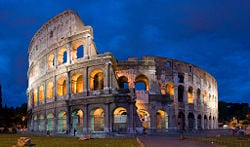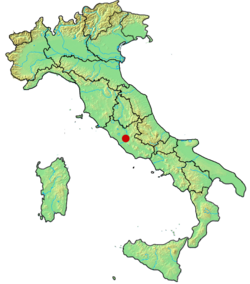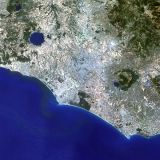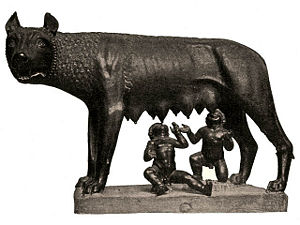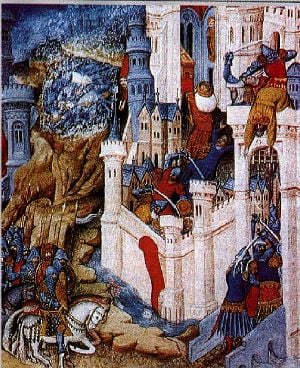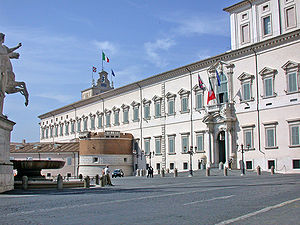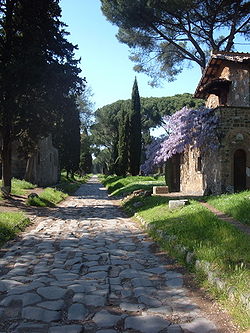Difference between revisions of "Rome" - New World Encyclopedia
Mike Butler (talk | contribs) |
Mike Butler (talk | contribs) |
||
| Line 61: | Line 61: | ||
d. trapped air pollution (also true in L.A. and Athens) | d. trapped air pollution (also true in L.A. and Athens) | ||
Elevation | Elevation | ||
| − | + | ||
| − | + | Rome enjoys a typical [[Mediterranean climate]]. The average maximum temperature in July is around 86°F (30°C) in July, although it can be uncomfortably hot, with temperatures often exceeding 95°F (35°C) at midday. Romans tend to close up their businesses during August to take holidays in cooler spots. The average maximum daytime temperature in January is 55°F (13°C). The Roman ''ottobrate'' or "beautiful October days" are known as sunny and warm days. Mean annual precipitation is 31 inches (790mm). | |
| + | |||
Rivers and canals | Rivers and canals | ||
Size – land area, size comparison | Size – land area, size comparison | ||
| Line 90: | Line 91: | ||
Consequently the density of the comune is not that high, the communal territory being divided between highly-urbanized areas and areas designated as parks, nature reserves, and agricultural use. The [[Province of Rome]] is the largest by area in Italy. At 5.352 km², its dimensions are comparable to the region of [[Liguria]], and more than three times the size of the greater metropolitan area of [[London]]. | Consequently the density of the comune is not that high, the communal territory being divided between highly-urbanized areas and areas designated as parks, nature reserves, and agricultural use. The [[Province of Rome]] is the largest by area in Italy. At 5.352 km², its dimensions are comparable to the region of [[Liguria]], and more than three times the size of the greater metropolitan area of [[London]]. | ||
| − | |||
| − | |||
| − | |||
| − | |||
| − | |||
| − | |||
==History == | ==History == | ||
Revision as of 04:42, 16 October 2008
| Comune di Roma | |||
|
|||
| Nickname: The Eternal City | |||
| Motto: Senātus Populusque Rōmānus (SPQR) (Latin) | |||
| Location of Rome | |||
| Coordinates: 41°54′N 12°30′E | |||
|---|---|---|---|
| Region | Lazio | ||
| Province | Rome (RM) | ||
| Founded | 21 April, 753 B.C.E. | ||
| Government | |||
| - Mayor | Giovanni Alemanno | ||
| Area | |||
| - City | 1,285 km² (496.1 sq mi) | ||
| - Urban | 5,352 km² (2,066 sq mi) | ||
| Elevation | +20 m (66 ft) | ||
| Population (December 2006)[1] | |||
| - City | 2,705,603 (1st) | ||
| - Density | 2,105.5/km² (4,664.8/sq mi) | ||
| - Urban | 4,013,057 | ||
| - Metro | 5,493,308 | ||
| Time zone | CET (UTC+1) | ||
| - Summer (DST) | CEST (UTC+2) | ||
| Postal codes | 00121 to 00199 | ||
| Area code(s) | 06 | ||
| Patron saints | Saint Peter and Saint Paul | ||
| Website: comune.roma.it | |||
Rome (pronounced /roʊm/; Italian: Roma, pronounced [ˈroma]; Latin: Roma) is the capital city of Italy and Lazio,[2] and is Italy's largest and most populous city, with 2,705,317 residents[3], an urban area of 3,457,690[4] as well as a metropolitan area of 3,849,000 inhabitants spread over a 5.352 km² area[5]. It is located in the central-western portion of the Italian peninsula, on the Tiber river.
Rome stands on top of more than two and a half thousand years of history, was once the largest city in the world and the centre of Western civilisation. Rome is still the heart of Christianity, being seat of the Roman Catholic Church which controls the Vatican City as its sovereign territory, an enclave of Rome.
Today, Rome is a modern, cosmopolitan city, and the third most-visited tourist destination in the European Union[6]. Due to its influence in politics, media, the arts and culture, Rome has been described as a global city.[7]
As one of the few major European cities that escaped World War II relatively unscathed, central Rome remains essentially Renaissance and Baroque in character. The historic centre of Rome is listed by UNESCO as a World Heritage Site.[8]
Geography
Etymology of name – if available. Topography: Physical qualities of a particular place. Example: Mexico City a. Mountain flanked basin b. on dry lake bed c. vulnerability to earthquakes d. trapped air pollution (also true in L.A. and Athens) Elevation
Rome enjoys a typical Mediterranean climate. The average maximum temperature in July is around 86°F (30°C) in July, although it can be uncomfortably hot, with temperatures often exceeding 95°F (35°C) at midday. Romans tend to close up their businesses during August to take holidays in cooler spots. The average maximum daytime temperature in January is 55°F (13°C). The Roman ottobrate or "beautiful October days" are known as sunny and warm days. Mean annual precipitation is 31 inches (790mm).
Rivers and canals Size – land area, size comparison Environmental issues Districts
Location
Rome is in the Lazio region of central Italy on the Tiber river (Italian: Tevere). The original settlement developed on hills which faced onto a ford beside the Tiber island, the only natural ford on the river. The historic centre of Rome was build on seven hills: the Aventine Hill, the Caelian Hill, the Capitoline Hill, the Esquiline Hill, the Palatine Hill, the Quirinal Hill, and the Viminal Hill. The city is also traversed by another river the Aniene with joins the Tiber to the north of the historic centre.
Although the city centre is about 24 kilometres (14.9 mi) inland from the Tyrrhenian Sea, the city territory extends to the very shore, where the south-western Ostia district is located. The altitude of the central part of Rome ranges from 13 m (43 ft) above sea level (at the base of the Pantheon) to 139 m (456 ft) above sea level (the peak of Monte Mario).[9] The comune of Rome covers an overall area of about 1,285 km² (496 sq mi), including many green areas.
Topography
Historically, the urban limits of Rome were considered to be the area within the city walls. Originally, these were the Servian Wall which was built twelve years after Gauls' sack of the city in 390 B.C.E. This contained most of the Esquiline and Caelian hills, as well as the whole of the other five. Rome grew out of the Servian Wall, but no more walls were constructed until almost 700 years later, when in 270 C.E. Emperor Aurelian began building the Aurelian Walls. These were almost 19 kilometres (12 mi) long, and were still the walls the troops of the Kingdom of Italy had to breach to enter the city in 1870. Modern Romans frequently consider the city's urban area to be delimited by its ring-road, the Grande Raccordo Anulare, which circles the city center at a distance of about 10km.
The Comune of Rome, however, covers considerably more territory and extends to the sea at Ostia, the largest town in Italy not to be a comune in its own right. The comune covers an area roughly three times the total area within the Raccordo and is comparable in area to the entire provinces of Milan and Naples, and to an area six times the size of the territory of these cities. The comune also includes considerable areas of abandoned marsh land which is neither suitable for agriculture nor for urban development.
Consequently the density of the comune is not that high, the communal territory being divided between highly-urbanized areas and areas designated as parks, nature reserves, and agricultural use. The Province of Rome is the largest by area in Italy. At 5.352 km², its dimensions are comparable to the region of Liguria, and more than three times the size of the greater metropolitan area of London.
History
From founding to Empire
Rome's early history is shrouded in legend. According to Roman tradition, the city was founded by the twins Romulus and Remus on April 21, 753 B.C.E.[10] Archaeological evidence supports the view that Rome grew from pastoral settlements on the Palatine Hill built in the area of the future Roman Forum. While some archaeologists argue that Rome was indeed founded in the middle of the 8th century B.C.E., the date is subject to controversy.[11] The original settlement developed into the capital of the Roman Kingdom (ruled by a succession of seven kings, according to tradition), and then the Roman Republic (from 510 B.C.E., governed by the Senate), and finally the Roman Empire (from 27 B.C.E., ruled by an Emperor). This success depended on military conquest, commercial predominance, as well as selective assimilation of neighbouring civilizations, most notably the Etruscans and Greeks. From its foundation Rome, although losing occasional battles, had been undefeated in war until 386 B.C.E., when it was briefly occupied by the Gauls.[12] According to the legend, the Gauls offered to deliver Rome back to its people for a thousand pounds of gold, but the Romans refused, preferring to take back their city by force of arms rather than ever admitting defeat, after which the Romans recovered the city in the same year.
Roman dominance expanded over most of Europe and the shores of the Mediterranean Sea, while its population surpassed one million inhabitants. For almost a thousand years, Rome was the most politically important, richest and largest city in the Western world, and remained so after the Empire started to decline and was split, even if it ultimately lost its capital status to Milan and then Ravenna, and was surpassed in prestige by the Eastern capital Constantinople.
Fall of the Empire and Middle Ages
With the reign of Constantine I, the Bishop of Rome gained political as well as religious importance, eventually becoming known as the Pope and establishing Rome as the centre of the Catholic Church. After the Sack of Rome in 410 C.E. by Alaric I and the fall of the Western Roman Empire in 476 C.E., Rome alternated between Byzantine and plundering by Germanic barbarians. Its population declined to a mere 20,000 during the Early Middle Ages, reducing the sprawling city to groups of inhabited buildings interspersed among large areas of ruins and vegetation. Rome remained nominally part of the Byzantine Empire rule until 751 C.E. when the Lombards finally abolished the Exarchate of Ravenna. In 756, Pepin the Short gave the pope temporal jurisdiction over Rome and surrounding areas, thus creating the Papal States.
Rome remained the capital of the Papal States until its annexation into the Kingdom of Italy in 1870; the city became a major pilgrimage site during the Middle Ages and the focus of struggles between the Papacy and the Holy Roman Empire starting with Charlemagne, who was crowned its first emperor in Rome in 800 by Pope Leo III. Apart from brief periods as an independent city during the Middle Ages, Rome kept its status of Papal capital and "holy city" for centuries, even when the Pope briefly relocated to Avignon (1309–1377).
Renaissance Rome
The latter half of the 15th century saw the seat of the Italian Renaissance move to Rome from Florence. The popes wanted to equal and surpass the grandeur of other Italian cities and to this end created ever more extravagant churches, bridges and public spaces, including a new Saint Peter's Basilica, the Sistine Chapel, Ponte Sisto (the first bridge to be built across the Tiber since antiquity), and Piazza Navona. The Popes were also patrians of the arts engaging such artists as Michelangelo, Perugino, Raphael, Ghirlandaio, Luca Signorelli, Botticelli and Cosimo Rosselli.
The period was also infamous for papal corruption with many popes fathering children, and engaging in nepotism and simony. The corruption of the Popes and the extravagance of their building projects led, in part, to the Reformation and, in turn, the Counter-reformation.
Towards the reunification of Italy
Italy became caught up in the nationalistic turmoils of the 19th century and twice gained and lost a short-lived independence. Rome became the focus of hopes of Italian reunification when the rest of Italy was reunited under the Kingdom of Italy with a temporary capital at Florence. In 1861 Rome was declared the capital of Italy even though it was still under the control of the Pope. During the 1860s the last vestiges of the Papal states were under French protection. And it was only when this was lifted in 1870, owing to the outbreak of the Franco-Prussian War, that Italian troops were able to capture Rome.
20th century
After a victorious World War I, Rome witnessed the rise to power of Italian fascism guided by Benito Mussolini, who marched on the city in 1922, eventually declared a new Empire and allied Italy with Nazi Germany. This was a period of rapid growth in population, from the 212,000 people at the time of unification to more than 1,000,000, but this trend was halted by World War II, during which Rome was damaged by both Allied forces bombing and Nazi occupation; after the execution of Mussolini and the end of the war, a 1946 referendum abolished the monarchy in favour of the Italian Republic.
Rome grew momentously after the war, as one of the driving forces behind the "Italian economic miracle" of post-war reconstruction and modernisation. It became a fashionable city in the 1950s and early 1960s, the years of la dolce vita ("the sweet life"), and a new rising trend in population continued till the mid-1980s, when the comune had more than 2,800,000 residents; after that, population started to slowly decline as more residents moved to nearby suburbs.
Government
Local
Rome constitutes one of Italy's 8,101 comunes, albeit the largest both by extent and population. It is governed by a Mayor, currently Giovanni Alemanno, and a city council. The seat of the comune is in on the Capitoline Hill the historic seat of government in Rome. The local administration in Rome is commonly referred to as "Campidoglio", the name of the hill in Roman dialect.
National
Rome is the national capital of Italy and is the seat of the Italian Government. The official residences of the President of the Italian Republic and the Italian Prime Minister, the seats of both houses of the Italian Parliament and that of the Italian Constitutional Court are located in the historic centre. While the state ministries are spread out around the city. These include the Ministry of Foreign Affairs which is located in Palazzo della Farnesina near the Olympic stadium.
Administrative divisions
Rome is divided into 19 administrative areas, called municipi or municipalities. They were created administrative reasons and to increase decentralisation in the city. Each municipality is governed by a president and a council of four members who are elected by the denizens of the municipality every five years. The municipalities frequently divide the traditional, non-administrative divisions of the city.
Rome is also divided into differing types of non-administrative divisions. The historic centre is divided into 22 rioni, all of which are located within the Aurelian walls except Prati and Borgo. After the designation of the newest and last rione, Prati, newer districts of the city were designated as quarters. There are 35 of these and they go all the way to the sea at Ostia, where they are called marine quarters. Rome also has six officially designated suburban zones and 52 agricultural zones. Many of the latter, however, have actuality been subject to considerable development.
Economy
Overview – Any specialization: For instance, is a manufactured product is associated with particular cities a. Milwaukee—cheese and beer b. Los Angeles—entertainment industry c. Sheffield—coal d. top 20 cities in the U.S. are highly specialized
Per capita GDP, rank Financial and business services sector Tourism Manufacturing
The city hosts the head offices of the vast majority of the major Italian companies, as well as the headquarters of three of the world's 100 largest companies: Enel, ENI, and Telecom Italia.[13]
Modern day Rome has a dynamic and diverse economy with thriving technologies, communications, and service sectors. It produces 6.7% of the national GDP (more than any other city in Italy). Rome grows +4,4% annually and continues to grow at a higher rate in comparison to any other city in the rest of the country. Following World War II Rome's economic growth began to overtake its rivals,[citation needed] Naples and Milan, although a traditional rivalry persists with Milan today. Tourism is inevitably one of Rome's chief industries, with numerous notable museums including the Vatican Museum, the Borghese Gallery, and the Musei Capitolini. Rome is also the hub of the Italian film industry, thanks to the Cinecittà studios. The city is also a centre for banking as well as electronics and aerospace industries. Numerous international headquarters, government ministries, conference centres, sports venues and museums are located in Rome's principal business districts: the Esposizione Universale Roma (EUR); the Torrino (further south from the EUR); the Magliana; the Parco de' Medici-Laurentina and the so-called Tiburtina-valley along the ancient Via Tiburtina.
Rome is at the centre of a network of roads which roughly follow the lines of the ancient Roman roads that began at the Capitoline Hill and connected Rome with its empire. This radial network causes considerable traffic problems. Today Rome is circled, at a distance of about 10km, by the ring-road called the Grande Raccordo Anulare.
Above ground public transport in Rome is made up of a bus and tram network. Rome has a two-line metro system called the Metropolitana, the building of which started in the 1930s.
Rome is a principal railway node for central Italy. Rome main train station, Termini is one of the biggest train stations in Europe, with 29 platforms, over 150 million passengers each year, with around 400,000 daily travellers.
Rome is served by three airports. Rome's international airport, Fiumicino, is Italy's chief airport. The older Rome Ciampino Airport is a joint civilian and military airport. The Aeroporto dell'Urbe, is a small, low-traffic airport located about 6 km north of the city centre, which handles most helicopter and private flights.
Demography
In 2007, there were 2,718,768 people residing in Rome (in which some 4 million live in the greater Rome area), located in the province of Rome, Lazio, of whom 47.2% were male and 52.8% were female. Minors (children ages 18 and younger) totalled 17.00 percent of the population compared to pensioners who number 20.76 percent. This compares with the Italian average of 18.06 percent (minors) and 19.94 percent (pensioners). The average age of Rome resident is 43 compared to the Italian average of 42. In the five years between 2002 and 2007, the population of Rome grew by 6.54 percent, while Italy as a whole grew by 3.56 percent.[14] The current birth rate of Rome is 9.10 births per 1,000 inhabitants compared to the Italian average of 9.45 births.
As of 2006, 92.63% of the population was Italian. The largest other ethnic groups came from other European countries (mostly from Romania and Poland): 3.14%, East Asia (mostly Filipino): 1.28%, and the Americas (mostly from Peru): 1.09%. It is also important to note that there are tens of thousands of illegal migrants living in Rome.
The original language of Rome was Latin, which evolved during the Middle Ages into Italian. The latter emerged as the confluence of various regional dialects, among which the Tuscan dialect predominated, but the population of Rome also developed its own dialect, the Romanesco. The ancient romanesco, used during the Middle Ages, was a southern Italian dialect, very close to the Neapolitan. The influence of the Florentine culture during the renaissance, and, above all, the immigration to Rome of many Florentines who were among the two Medici Popes' (Leo X and Clement VII) suite, caused a strong change of the dialect, which resembled more the Tuscan varieties (the immigration of Florentines was mainly due to the Sack of Rome in 1527 and the subsequent demographic decrease). This remained largely confined to Rome until the 19th century, but then expanded to other zones of Lazio (Civitavecchia, Latina), from the beginning of the 20th century, thanks to the rising population of Rome and to better transportation systems. As a consequence, Romanesco abandoned its traditional forms to mutate into the dialect spoken within the city, which is more similar to standard Italian, although remaining distinct from other Romanesco-influenced local dialects of Lazio. Dialectal literature in the traditional form Romanesco includes the works of such authors as Giuseppe Gioacchino Belli, Trilussa, and Cesare Pascarella. Contemporary Romanesco is mainly represented by popular actors such as Aldo Fabrizi, Alberto Sordi, Nino Manfredi, Anna Magnani, Gigi Proietti, Enrico Montesano, and Carlo Verdone.
Rome is the centre of the Roman Catholic religion and much in common with the rest of Italy, the large majority of Romans are Roman Catholics. In recent years, the Islamic community in Rome has grown significantly, in great part due to immigration from North African and Middle Eastern countries into the city. As a consequence of this trend, the city promoted the building of the largest mosque in Europe, which was designed by architect Paolo Portoghesi and inaugurated on 21 June 1995.
Rome is a nation-wide centre for higher education. Its first university, La Sapienza (founded in 1303), is the largest in Europe and the second largest in the world, with more than 150,000 students attending.[citation needed] Two new public universities were founded: Tor Vergata in 1982, and Roma Tre in 1992, although the latter has now become larger than the former. Rome also contains a large number of pontifical universities and institutes, including the Pontifical Gregorian University (The oldest Jesuit university in the world, founded in 1551), the Pontifical University of St. Thomas Aquinas, and many others. The city also hosts various private universities, such as the LUMSA, the Università Cattolica del Sacro Cuore (Roman centre), the LUISS, Istituto Europeo di Design, the St. John's University, the John Cabot University, the IUSM, the American University of Rome, the Scuola Lorenzo de' Medici, the Link Campus of Malta, the S. Pio V University of Rome, and the Università Campus Bio-Medico. Rome is also the location of the John Felice Rome Centre, a campus of Loyola University Chicago.
xxxxx At the time of emperor Augustus, Rome was the largest city in the world, and probably the largest ever built until the nineteenth century. Estimates of its peak population range from 450,000 to over 3.5 million people with 1 to 2 million being most popular with historians. After the fall of the Roman Empire, the city's population fell dramatically to around less than 50,000 people, and continued to either stagnate or shrink until the Renaissance.
When the Kingdom of Italy annexed Rome in 1870, it had a population of about 200,000, which rapidly increased to 600,000 at the eve of World War I. The fascist regime of Mussolini tried to block an excessive demographic rise of the city, but failed to prevent it from reaching one million people by 1931. After the second world war, growth continued, helped by a post-war economic boom. A construction boom also created a large number of suburbs during the 1950s and 1960s
Of interest
Cityscape

Architecture
Ancient Rome
One of the symbols of Rome is the Colosseum (70–80 C.E.), the largest amphitheatre ever built in the Roman Empire. Originally capable of seating 60,000 spectators, it was used for gladiatorial combat. The list of the very important monuments of ancient Rome includes the Roman Forum, the Domus Aurea, the Pantheon, Trajan's Column, Trajan's Market, the Catacombs, the Circus Maximus, the Baths of Caracalla, Castel Sant'Angelo, the Mausoleum of Augustus, the Ara Pacis, the Arch of Constantine, the Pyramid of Cestius, and the Bocca della Verità.
Medieval
Often overlooked, Rome's medieval heritage is one of the largest in Italian cities. Basilicas dating from the Paleochristian age include Santa Maria Maggiore and San Paolo Fuori le Mura (the latter largely rebuilt in the 19th century), both housing precious 4th century AD mosaics. Later notable medieval mosaic and fresco art can be also found in the churches of Santa Maria in Trastevere, Santi Quattro Coronati and Santa Prassede. Lay buildings include a number of towers, the largest being the Torre delle Milizie and the Torre dei Conti, both next the Roman Forum, and the huge staircase leading to the basilica of Santa Maria in Ara Coeli.
Renaissance and Baroque
Rome was a major world centre of the Renaissance, second only to Florence, and was profoundly affected by the movement. The most impressive masterpiece of Renaissance architecture in Rome is the Piazza del Campidoglio by Michelangelo, along with the Palazzo Senatorio, seat of the city government. During this period, the great aristocratic families of Rome used to build opulent dwellings as the Palazzo del Quirinale (now seat of the President of the Italian Republic), the Palazzo Venezia, the Palazzo Farnese, the Palazzo Barberini, the Palazzo Chigi (now seat of the Italian Prime Minister), the Palazzo Spada, the Palazzo della Cancelleria, and the Villa Farnesina.
Rome is also famous for her huge and majestic squares (often adorned with obelisks), many of which were built in the 17th century. The principal squares are Piazza Navona, Piazza di Spagna, Campo de' Fiori, Piazza Venezia, Piazza Farnese and Piazza della Minerva. One of the most emblematic examples of the baroque art is the Fontana di Trevi by Nicola Salvi. Other notable baroque palaces of 17th century are the Palazzo Madama, now seat of the Italian Senate and the Palazzo Montecitorio, now seat of the Chamber of Deputies of Italy.
Neoclassicism
In 1870, Rome became capital city of the new Kingdom of Italy. During this time, neoclassicism, a building style influenced by the architecture of antiquity, became a predominant influence in Roman architecture. In this period many great palaces in neoclassical styles were built to host ministries, embassies and other governing agencies. One of the best-known symbol of Roman neoclassicism is the Monument of Vittorio Emanuele II or "Altar of Fatherland", where the Grave of the Unknown Soldier, that represents the 650,000 Italians that fell in World War I, is located.
Fascist architecture
The Fascist regime that ruled in Italy between 1922 and 1943 developed an architectural style which was characterized by its links with ancient Roman architecture. The most important fascist site in Rome is the E.U.R. district, designed in 1938 by Marcello Piacentini. It was originally conceived for the 1942 world exhibition, and was called "E.42" ("Esposizione 42"). The world exhibition, however, never took place because Italy entered the Second World War in 1940. The most representative building of the Fascist style at E.U.R. is the Palazzo della Civiltà Italiana (1938–1943), the iconic design of which has been labelled the cubic or Square Colosseum.
After World War II, the Roman authorities found that they already had the seed of an off-centre business district that other capitals were still planning (London Docklands and La Defense in Paris). Also the Palazzo della Farnesina, the current seat of Italian Foreign Ministry, was designed in 1935 in fascist style.
Public parks and nature reserves
Public parks and nature reserves cover a large area in Rome, and the city has one of the largest areas of green space amongst European capitals.[15]. The most notable part of this green space is represented by the large number of villas and landscaped gardens created by the Italian aristocracy. While many villas were destroyed during the building boom of the late 19th century, a great many nonetheless remain. The most notable of these are Villa Borghese, Villa Ada, and Villa Doria Pamphili.
Rome has a number of regional parks of much more recent origin including the Pineto Regional Park and the Appian Way Regional Park. There are also nature reserves at Marcigliana and at Tenuta di Castelporziano.
Museums and galleries
The most important museums and galleries of Rome include the National Museum of Rome, the Museum of Roman Civilization, the Villa Giulia National Etruscan Museum, the Capitoline Museums, the Borghese Gallery, the Museum of Castel Sant'Angelo, and the National Gallery of Modern Art.
Culture
Music
Rome is an important centre for music. It hosts the Accademia Nazionale di Santa Cecilia (founded in 1585), for which new concert halls have been built in the new Parco della Musica, one of the largest musical venues in the world. Rome also has an opera house, the Teatro dell'Opera di Roma, as well as several minor musical institutions. The city also played host to the Eurovision Song Contest in 1991 and the MTV Europe Music Awards in 2004.
Cinema
Rome hosts the Cinecittà Studios, the largest film and television production facility in continental Europe and the centre of the Italian cinema, where a large number of today's biggest box office hits are filmed. The 99 acre (40 ha) studio complex is 5.6 miles (9 km) from the centre of Rome and is part of one of the biggest production communities in the world, second only to Hollywood, with well over 5,000 professionals — from period costume makers to visual effects specialists. More than 3,000 productions have been made on its lot, from recent features like The Passion of the Christ, Gangs of New York, HBO’s Rome, The Life Aquatic and Dino De Laurentiis’ Decameron, to such cinema classics as Ben Hur, Cleopatra and the films of Federico Fellini.
Founded in 1937 by Benito Mussolini, the studios were bombed by the Western Allies during World War II. In the 1950s, Cinecittà was the filming location for several large American film productions, and subsequently became the studio most closely associated with Federico Fellini. Today Cinecittà is the only studio in the world with pre-production, production and full post-production facilities on one lot, allowing directors and producers to walk in with their script and "walk out" with a completed film.
Media
| Newspapers | Magazines | Television | Radio |
|---|---|---|---|
|
|
|
See also List of radio stations in Rome. |
Sports
| Club | Sport | Founded | League | Venue | Head Coach |
|---|---|---|---|---|---|
| A.S. Roma | Football (soccer) | 1927 | Serie A | Stadio Olimpico | Luciano Spalletti |
| S.S. Lazio | Football (soccer) | 1900 | Serie A | Stadio Olimpico | Delio Rossi |
| A.S. Cisco Roma | Football (soccer) | 1972 | Serie C2 | Stadio Flaminio | Fabio Fratena |
| Pallacanestro Virtus Roma | Basketball | 1960 | Serie A | PalaLottomatica | Jasmin Repeša |
| M. Roma Volley | Volleyball | 2006 | A 1 | Palazzetto dello Sport | Roberto Serniotti |
| Unione Rugby Capitolina | Rugby union | 1996 | Super 10 | Stadio Flaminio | Massimo Mascioletti |
Rome hosted the 1960 Summer Olympics and is an official candidate to hosting the 2020 Summer Olympics.
Football is the most popular sport in Rome, as in the rest of the country. The Olympic Stadium hosted the final game of the 1990 FIFA World Cup; it is also the home stadium for local Serie A clubs A.S. Roma and S.S. Lazio, whose rivalry has become a staple of Roman sports culture. Indeed, famous footballers who play for these teams and are also born in the city tend to become especially popular, as has been the case with players such as Francesco Totti and Daniele De Rossi (both for A.S. Roma).
While far from being as popular as football, Rugby union is gaining wider acceptance. The Stadio Flaminio is the home stadium for the Italy national rugby union team, which has been playing in the Six Nations Championship since 2000, albeit with less than satisfactory performances, as they have never won the championship so far. Rome is home to local rugby teams, such as Unione Rugby Capitolina, Rugby Roma, and S.S. Lazio.
Every May, Rome hosts the ATP Masters Series tennis tournament on the clay courts of the Foro Italico. Cycling was immensely popular in the post-WWII period, although its popularity has faded in the last decades; Rome has hosted the final portion of the Giro d'Italia twice, in 1989 and 2000. Rome is also home to many other sports teams, including basketball (Virtus Roma), volleyball (M. Roma Volley), handball or waterpolo.
| Historic Centre of Rome, the Properties of the Holy See in that City Enjoying Extraterritorial Rights and San Paolo Fuori le Mura* | |
|---|---|
| UNESCO World Heritage Site | |
250px | |
| Type | Cultural |
| Criteria | i, ii, iii, iv, vi |
| Reference | {{{ID}}} |
| Region** | Europe and North America |
| Inscription history | |
| Inscription | {{{Year}}} (Unknown Session) |
| Extensions | 1990 |
| * Name as inscribed on World Heritage List. ** Region as classified by UNESCO. | |
International entities, organisations and involvement
- See also: Vatican City
Rome is unique in having a sovereign state located entirely within its city limits, the Vatican City. The Vatican is a enclave of Rome and a sovereign possession of the Holy See the supreme government of the Roman Catholic Church. Rome hosts foreign embassies to both Italy and the Holy See, although frequently the same ambassador is accredited to both.
Another body the Sovereign Military Order of Malta (SMOM) took refuge in Rome in 1834 after having lost Malta to Napoleon. It is sometimes classified as having sovereignty but doesn't claim any territory in Rome or anywhere else, hence leading to dispute over its actual sovereign status.
Rome is also the seat of significant international organisations of the United Nations, such as the World Food Program (WFP), the Food and Agriculture Organization (FAO), and the International Fund for Agricultural Development (IFAD).
Rome has traditionally been heavily involved in the process of European political integration. In 1957, the city hosted the signing of the Treaty of Rome, which established the European Economic Community (predecessor to the European Union), and also played host to the official signing of the proposed European constitution in July 2004.
Rome was also where the Statute of the International Criminal Court was formulated.
See also
- Churches of Rome
- Glocal Forum, the International on-governmental organization with main office located in Rome
- Large Cities Climate Leadership Group
- List of ancient monuments in Rome
- Shopping areas and markets in Rome
Notes
- ↑ http://demo.istat.it/bilmens2006/index.html ISTAT demographics
- ↑ Rome (Italy). Encarta. Retrieved 2008-05-10.
- ↑ http://demo.istat.it March 2008
- ↑ Urban Audit 2004
- ↑ Istituto Superiore per la Protezione e la Ricerca Ambientale
- ↑ Top 150 City Destinations London Leads the Way
- ↑ Ambe J. Njoh, Tradition, Culture and Development in Africa. Historical Lessons for Modern Development Planning, Ashgate, London 2006, p. 2; K. Christensen, D. Levinson, Encyclopedia of Community: From the Village to the Virtual World, SAGE 2003, p. 528
- ↑ Historic Centre of Rome, the Properties of the Holy See in that City Enjoying Extraterritorial Rights and San Paolo Fuori le Mura. UNESCO World Heritage Center. Retrieved 2008-06-08.
- ↑ Ravaglioli, Armando (1997). Roma anno 2750 ab Urbe condita. Rome: Tascabili Economici Newton. ISBN 888183670X.
- ↑ Rome: Pre-20th-Century History. Lonely Planet. Retrieved 2008-07-04.
- ↑ Wilford, John Nobel, "More Clues in the Legend (or Is It Fact?) of Romulus", New York Times, 2007-06-12. Retrieved 2008-08-11.
- ↑ Livy, Book 5.
- ↑ DeCarlo, Scott, "The World's 2000 Largest Public Companies", Forbes, 2006-03-30. Retrieved 2007-01-16.
- ↑ http://demo.istat.it/bil2007/index.html
- ↑ www.romaperkyoto.org
Further reading
- Lucentini, Mario (2002). La Grande Guida di Roma (in Italian). Rome: Newton & Compton Editori. ISBN 88-8289-053-8.
- Spoto, Salvatore (1999). Roma Esoterica (in Italian). Rome: Newton & Compton Editori. ISBN 88-8289-265-4.
- Richard Brilliant (2006). Roman Art. An American's View. Rome: Di Renzo Editore. ISBN 88-8323-085-X.
Documentaries
- The Holy Cities: Rome produced by Danae Film Production, distributed by HDH Communications; 2006.
External links
- Official
- Official site of the City of Rome (Italian)
- APT (official Tourist Office) of the City of Rome (English)
- Rome Museums — Official site (Italian)
- Vatican Museums (English)
- Capitoline Museums (English)
- Other
- Travel guide to Rome from Wikitravel
- Rome travel guides at the Open Directory Project
- City models of Ancient Rome
Credits
New World Encyclopedia writers and editors rewrote and completed the Wikipedia article in accordance with New World Encyclopedia standards. This article abides by terms of the Creative Commons CC-by-sa 3.0 License (CC-by-sa), which may be used and disseminated with proper attribution. Credit is due under the terms of this license that can reference both the New World Encyclopedia contributors and the selfless volunteer contributors of the Wikimedia Foundation. To cite this article click here for a list of acceptable citing formats.The history of earlier contributions by wikipedians is accessible to researchers here:
The history of this article since it was imported to New World Encyclopedia:
Note: Some restrictions may apply to use of individual images which are separately licensed.
